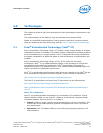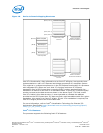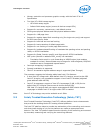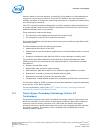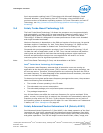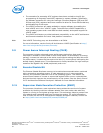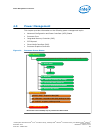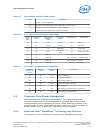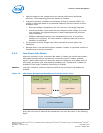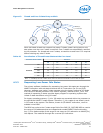
digital signal processing software. FMA improves performance in face detection,
professional imaging, and high performance computing. Gather operations increase
vectorization opportunities for many applications. In addition to the vector extensions,
this generation of Intel processors adds new bit manipulation instructions useful in
compression, encryption, and general purpose software.
For more information on Intel AVX, see http://www.intel.com/software/avx
Intel
®
Advanced Encryption Standard New Instructions
(Intel
®
AES-NI)
The processor supports Intel Advanced Encryption Standard New Instructions (Intel
AES-NI) that are a set of Single Instruction Multiple Data (SIMD) instructions that
enable fast and secure data encryption and decryption based on the Advanced
Encryption Standard (AES). Intel AES-NI are valuable for a wide range of
cryptographic applications, such as applications that perform bulk encryption/
decryption, authentication, random number generation, and authenticated encryption.
AES is broadly accepted as the standard for both government and industry
applications, and is widely deployed in various protocols.
Intel AES-NI consists of six Intel SSE instructions. Four instructions, AESENC,
AESENCLAST, AESDEC, and AESDELAST facilitate high performance AES encryption
and decryption. The other two, AESIMC and AESKEYGENASSIST, support the AES key
expansion procedure. Together, these instructions provide a full hardware for
supporting AES; offering security, high performance, and a great deal of flexibility.
PCLMULQDQ Instruction
The processor supports the carry-less multiplication instruction, PCLMULQDQ.
PCLMULQDQ is a Single Instruction Multiple Data (SIMD) instruction that computes the
128-bit carry-less multiplication of two, 64-bit operands without generating and
propagating carries. Carry-less multiplication is an essential processing component of
several cryptographic systems and standards. Hence, accelerating carry-less
multiplication can significantly contribute to achieving high speed secure computing
and communication.
Intel
®
Secure Key
The processor supports Intel
®
Secure Key (formerly known as Digital Random Number
Generator (DRNG)), a software visible random number generation mechanism
supported by a high quality entropy source. This capability is available to
programmers through the RDRAND instruction. The resultant random number
generation capability is designed to comply with existing industry standards in this
regard (ANSI X9.82 and NIST SP 800-90).
Some possible usages of the RDRAND instruction include cryptographic key generation
as used in a variety of applications, including communication, digital signatures,
secure storage, and so on.
Intel
®
Transactional Synchronization Extensions - New
Instructions (Intel
®
TSX-NI)
Intel Transactional Synchronization Extensions - New Instructions (Intel TSX-NI). Intel
TSX-NI provides a set of instruction extensions that allow programmers to specify
regions of code for transactional synchronization. Programmers can use these
3.6
3.7
Processor—Technologies
Desktop 4th Generation Intel
®
Core
™
Processor Family, Desktop Intel
®
Pentium
®
Processor Family, and Desktop Intel
®
Celeron
®
Processor Family
Datasheet – Volume 1 of 2 December 2013
46 Order No.: 328897-004




